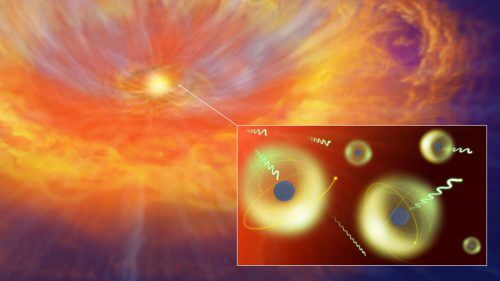Physicists working in the atomic field of nuclear fusion have succeeded in obtaining the most accurate computer calculations in the world regarding the atomic data of neodymium ions used in the analysis of the light reflected from a neutron star merger event. This research may accelerate the pace of solving the long-standing mystery about the cosmic origin of heavy elements

[Translation by Dr. Nachmani Moshe]
A team of researchers of experts in the fields of atomic physics, nuclear fusion and astronomy, managed to obtain the most accurate computer calculations in the world regarding the atomic data of neodymium ions used in the analysis of the light reflected from the event of a merger of a pair of neutron stars. This research advances the solution of the question as to the cosmic origin of precious metals such as gold and platinum common in our universe.
It has not yet been clarified where and how the elements heavier than iron in the universe were formed. The researchers believe that one of the sources of heavy elements may be the merger of two neutron stars. In 2017, gravitational waves resulting from the merger of two neutron stars were discovered, an event that occurred 130 million years ago. At the same time, the emission of a beam of light known as a kilonova was also observed. This beam of light originates from the material that was released during the fusion of the neutron stars, and the researchers believe that this material includes an abundance of heavy elements, including precious metals such as gold and platinum, as well as rare metals, such as neodymium.
The different elements have the ability to absorb light. The wavelength of the light absorbed by the elements and the level of absorption of this light are unique to each and every one of the separate elements and are referred to as atomic data. By using atomic data, the researchers are able to estimate the nature and concentration of the heavy elements formed during neutron star mergers by analyzing the brightness and wavelength distribution of the kilonova light beam. At the same time, the available atomic data about heavy elements is extremely limited within the global databases of the National Institute of Standards and Technology (NIST). Therefore, joint research is being carried out in the fields of atomic physics, astronomy and nuclear fusion science with the aim of providing more accurate atomic data within the framework of kilonova light beam research. In the field of nuclear fusion research, atomic data are necessary for the analysis of the amount and emission of impurities such as iron ions in plasmas at high temperatures.
Computing methods used in nuclear fusion research can be used to analyze the atomic data of the light arriving within the kilonova beam. The research team focused on neodymium ions ionized once, twice or three times, which have the greatest effect on this light beam. The heavy element neodymium can form many more types of electron configurations compared to lighter elements, such as iron, which are able to provide a vast number of wavelengths to absorb light.
High-precision computing of multi-electron atoms is challenging due to the difficulties in calculating the delicate interactions between the various electrons. In quantum mechanics, correlation results are represented by a coherent combination of different states of the electrons that create mutual relations between them. Theoretically, an infinite number of situations are possible. The research team examined different collections of states with the goal of providing as accurate data as possible in realistic computing times, and was able to find the best collection of states for each of the neodymium ions. The energies calculated for the relevant electrons match the existing data in the databases with an average deviation error of 10%, which is a higher level of accuracy than any achieved so far by the research team, while providing millions of wavelengths and probabilities for light absorption. The researchers hope that the findings of this study will accelerate research aimed at uncovering the origins of precious metals such as gold and platinum in our universe, using the highest precision atomic data.
to the notice of the researchers
- More of the topic in Hayadan:
- "With the LIGO upgrade we will be able to discover dozens of gravitational wave events per year"
- Researchers have retrospectively identified another event of gravitational waves from colliding neutron stars
- Inflation, Gravitational Waves and the Cosmic Background Radiation: Theory and Experimental Verification\

3 תגובות
That makes a little more sense.
Thanks
For "anonymous user":
The writing style in the posting here is a bit confusing; What I write here is much more "rough", but perhaps it will clarify the point better:
Protons and electrons are not lacking in the universe; However, neutrons - which are created, among other things, from the fusion of a proton and an electron at high energies - were in lower quantities already in the early universe (300,000 years after the big bang).
In the process of merging neutron stars, a lot of neutrons are emitted into space, which later bind to more protons and neutrons, and this is how the heavier elements are formed. Without enough neutrons in the universe, the "weak force" in the nuclei of atoms simply does not allow the use of only protons or the use of protons and a few neutrons in the nuclei of elements "heavier" than hydrogen.
In summary: Neutron star fusion - despite their low frequency - is the process that produces and scatters most neutrons throughout the universe, thus enabling the construction of nuclei of heavier atoms.
That sounds a little statistically unreasonable. The collision of neutron stars is a rather rare event in the universe, is it possible that the origin of all the heavy elements in the universe is only this type of occurrence?